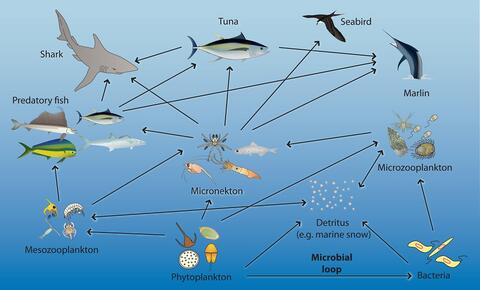Understanding the interactions between species to develop ecosystem-based approaches to fisheries management
Improving our understanding of the structure and dynamics of pelagic ecosystems is critical to developing ecosystem-based approaches to fisheries management. This understanding allows us to assess the impacts of fishing activities and environmental factors not only on target stocks, but also on all other species including by-catch and protected species belonging to this ecosystem.
The structure of the ecosystem is based on prey-predator relationships that are the most important interactions between species. Studying these interactions, or the trophic dynamics (who eats who, where, and when), enables us to develop ecosystem models. These models provide the basis to test ecosystem-based management options and provide management and monitoring advice to the Western and Central Pacific Fisheries Commission (WCPFC) and Pacific small island developing states. This information has the ability to help us understand and predict changes in the ecosystem due to environmental variability (for example, El Niño) and fisheries. It is then an important tool to test and assess the impact of fisheries management regulations on the entire ecosystem.

What is the pelagic food web?
Tuna are top predators in the pelagic food web, along with other species such as sharks and billfish. They consume smaller predators, mainly micronekton which are small (2-20cm) marine animals such as squid, crustaceans, and gelatinous organisms. While micronekton are not targeted by fisheries, they are central to the food web, constituting the food of all top predators. Micronekton are dependent on the lower levels of the food web such as zooplankton and phytoplankton.
How do we study the pelagic food web?
We developed several approaches to study the food web and trophic dynamics so that we can understand and visualise the nutrient and energy flows and species interactions within these ecosystems. These mechanisms are central to ecosystem-based fisheries management so we can optimise the fish stocks and protect other species from the impacts of fishing.
By looking at the stomach contents of tuna and other predators, we can characterise quantitatively and qualitatively the prey-predator relationships between all the components or species of the ecosystem. This can also provide knowledge about the diversity of species present in the ecosystem. By examining the morphology (the shape) of the stomach contents, and by analysing the DNA and comparing this to reference libraries to match it to the closest species, we can identify the prey. This helps us to understand the natural mortality in the fish populations, which greatly influences the fish stock dynamics.
We use other complementary methods to provide more details about the diet, trophic level, and habitat of these animals; for example, measuring the levels of stable isotopes of nitrogen and carbon in the muscle tissues of fish. This tells us a little more about the longer-term dietary habits of the fish as these elements accumulate in the tissues over time, whereas the stomach contents tell us about the last meal. Similarly, micronekton can also be collected in specialised fishing nets and are then examined and identified in the FAME laboratories, giving us more details about the pelagic food web in addition to the stomach contents.
Since 2000, SPC has developed a large sampling program to collect fish stomachs and tissues across the region with the support of the national observer and port sampler programmes of the Pacific countries and territories. Observers collect biological samples onboard tuna fishing vessels and port samplers collect samples in offloading facilities and canneries on land. Scientists also collect samples during tuna tagging cruises. Samples are preserved frozen and sent to SPC along with the data identifying the species and area sampled. These samples are recorded in the Pacific Marine Specimen Bank.
